Dr. Antje Voegele
Postdoctoral Research Assistant since 2013
Research assistant (RHUL) and PhD student 2010-2013
DFG project 'Brassicaceae
seed dormancy mechanisms'
Email: Antje.Voegele@rhul.ac.uk
Phone: ++44-(0)1784-44-nnnn (office group Leubner)
Phone: ++44-(0)1784-44-3895 (lab 3-27)
School of Biological Sciences
Royal Holloway, University of London (RHUL)
Egham, Surrey, TW20 0EX, United Kingdom
Research interests:
- Hormonal regulation of seed germination
- Interactions between seed tissues and organs
- Effects of abiotic stress (in particular sub- and supraoptimal temperatures) on seed germination and embryo growth
- Comparative approaches using different Brassicaceae species
- Phylogenetic analyses
My project: Seed germination of endospermic Brassicaceae
Academic career
Publications and
presentations at international conferences
 |
 |

|
 |
| |
|
My project:
Project background
|
|
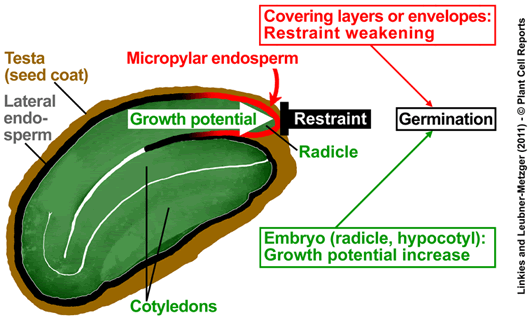
Mature seeds of the Brassicaceae species Lepidium sativum possess a thin endosperm layer surrounding the embryo, which regulates germination by acting as a constraint to radicle protrusion. Prior to endosperm rupture and radicle protrusion, the embryo radicle/hypocotyl axis (RAD) elongates due to cell expansion growth and the micropylar endosperm (CAP) weakens. Endosperm weakening is initiated by an early embryo signal, proceeds in an organ autonomous manner and is promoted by gibberellins (GA) and inhibited by abscisic acid (ABA). Molecular mechanisms of endosperm CAP weakening depend on hormonally and environmentally regulated expression of cell wall remodeling proteins and reactive oxygen species (ROS). The size of L. sativum seeds allows direct mechanical tissue-specific analyses, such as puncture-force measurements of the endosperm tissue and detailed quantification of embryo organ sizes, but also quantification of GA and ABA contents and mRNA transcript abundances by quantitative (real-time) RT-PCR (qRT-PCR).
Title of my PhD Thesis (01.2010 - current): "Comparative analysis of hormone interactions during Brassicaceae seed germination".
|
 |
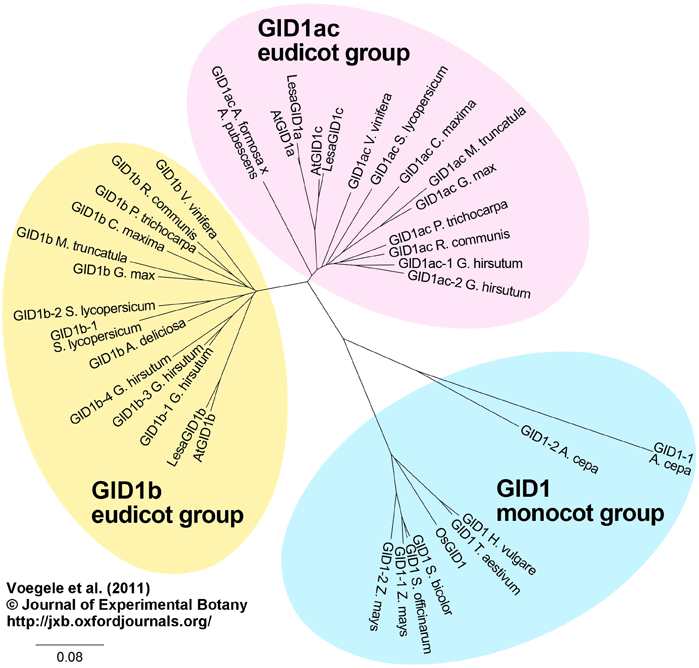 |
Major findings
Molecular phylogenetic analysis of angiosperm GIBBERELLIN INSENSITIVE DWARF1 (GID1) gibberellin receptors reveals that they cluster into two eudicot (GID1ac, GID1b) groups and one monocot group. Eudicots have at least one gene from each of the two groups, indicating that the different GID1 receptors fulfill distinct roles during plant development. In a comparative approach in which gid1 mutant and whole-seed transcript analyses in Arabidopsis were combined with seed-tissue-specific analyses of its close relative Lepidium sativum (garden cress), we have shown that signaling via the GID1ac receptors is required for seed germination. Transcript expression patterns differed temporarily, spatially, and hormonally, with GID1b being distinct from GID1ac. Their transcript expression patterns in both species strongly suggest that they are regulated by distinct GID1-mediated GA signalling pathways. Expansins and xyloglucan endo-transglycosylases/hydrolases (XTHs) are involved in endosperm weakening and are regulated by distinct GID1-mediated GA signalling pathways. The GID1ac and GID1b pathways seem to fulfill distinct regulatory roles during Brassicaceae seed germination and seem to control their downstream targets distinctly (Voegele et al. 2011).
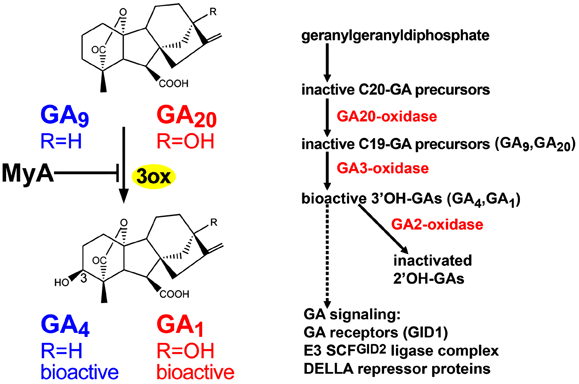
Myrigalone A is a rare flavonoid in fruit leachates of Myrica gale, a deciduous shrub adapted to flood prone habitats. MyA is a putative allelochemical and inhibits L. sativum seed germination. We have shown that MyA delays endosperm rupture and affects the mechanical properties of the CAP tissue (Oracz et al. 2012). Weakening of the micropylar endosperm (CAP) is inhibited and this effect is much stronger in darkness. MyA treated seeds require a 1.4 fold larger embryo than the control for displaying 50% of endosperm rupture. Permeability of L. sativum seed envelopes (testa, endosperm) is increased by MyA, mediating an increase in the water uptake rate and altering testa properties. Apoplastic ROS production in specific zones of L. sativum RAD important for cell expansion growth is inhibited by MyA which acts as a radical scavenger. Our data revealed that MyA also severely interferes with gibberellin metabolism by inhibiting GA3-oxidase as well as with the GID1-type GA signaling pathway. The phytotoxic effects of the putative allelochemical MyA are achieved by targeting several key steps of seed germination and seedling establishment, securing the persistence of M. gale in a flood prone environment by degrading the surrounding soil seed bank (Voegele et al 2012)
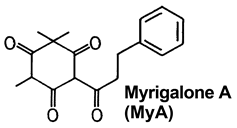
For my publications and presentations at conferences: See list below.
|
 |
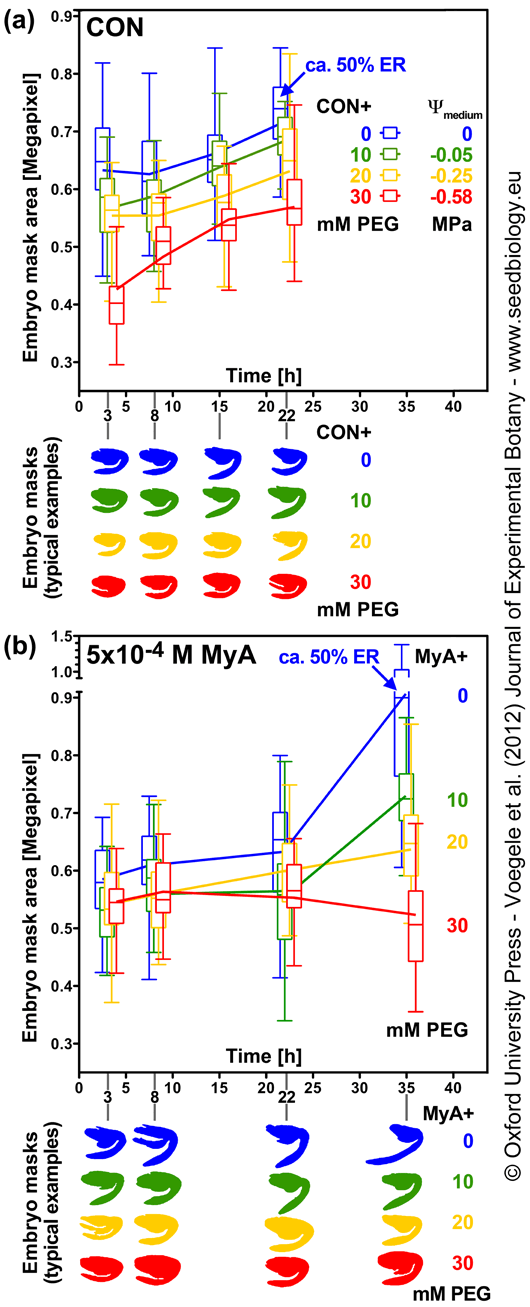 |
|
 |
|


| |
Academic career |
 |
|
|
 |
 |
 |
Since April 2012
 |
|
Research Assistant in the DFG project “Seed Dormancy Mechanisms”
in Gerhard Leubners seed biology laboratory at the School of Biological Sciences,
Royal Holloway, University of London, Egham, Surrey, United Kingdom
 |
Since 2010
 |
 |
Member of the ISSS (International Society for Seed Science)
 |
Since January 2010
 |
 |
PhD project, experimental work ”Comparative analysis of hormone interactions during Brassicaceae seed germination”
Department of Botany/Plant Physiology, Albert-Ludwigs-University Freiburg, Freiburg i.Br., Germany
Supervisor: Professor Dr. Gerhard Leubner
 |
22.12.2009
 |
 |
Diploma degree as a biologist (equals Master of Science)
Thesis: „Comparative analysis of the role of the gibberellin receptor GID1 during Arabidopsis thaliana and Lepidium sativum seed germination“ Thesis grade: 1.0 (very good)
Department of Botany/Plant Physiology, Albert-Ludwigs-University Freiburg, Freiburg i.Br., Germany
Supervisor: PD Dr. Gerhard Leubner
 |
09/2004-12/2009
 |
 |
Academic studies (Diploma, equals Master of Science) in Biology
(Plant Physiology, Plant Biotechnology and Genetics) at
Albert-Ludwigs-University Freiburg, Freiburg i. Br., Germany
 |
 |
 |
 |
 |
 |
|
|
|


| |
Publications and
presentations at international conferences |
 |
|
|
Peer-reviewed publications
Voegele, A., Linkies, A., Müller, K. and Leubner-Metzger, G. (2011)
Members of the gibberellin receptor gene family (GIBBERELLIN INSENSITIVE DWARF1) play distinct roles during Lepidium sativum and Arabidopsis thaliana seed germination.
Journal of Experimental Botany 62: 5131-5147
Rentzsch, S., Podzimska, D., Voegele, A., Imbeck, M., Müller, K., Linkies, A. and Leubner-Metzger, G. (2012)
Dose- and tissue-specific interference of monoterpenes with the gibberellin-mediated release of potato tuber bud dormancy, sprout growth and induction of alpha-amylases and beta-amylases.
Planta 235: 137-151
Oracz, K., Voegele, A., Tarkovská, D., Jacquemoud, D., Turecková, V., Urbanová, T., Strnad, M., Sliwinska, E. and Leubner-Metzger, G. (2012)
Myrigalone A inhibits Lepidium sativum seed germination by interference with gibberellin metabolism and apoplastic superoxide production required for embryo extension growth and endosperm rupture.
Plant and Cell Physiology 53: 81-95
Voegele, A., Graeber, K., Oracz, K., Tarkowská, D., Jacquemoud, D., Ture?ková, V., Urbanová T., Strnad, M. and Leubner-Metzger, G. (2012)
Embryo growth, testa permeability and endosperm weakening are major tar-gets for the inhibition of Lepidium sativum seed germination by myrigalone A.
Journal of Experimental Botany 63: 5337-5350
Oral presentations at international conferences and invited seminars
| 02/2010 |
|
Institute of Experimental Botany, Palacky University, Olomouc, Czech Republic:
“Comparative seed biology - A reverse genetics approach to study Endosperm weakening using Brassicaceae relatives “
|
| 07/2010 |
|
3rd Workshop on the molecular aspects of seed dormancy and germination, International Society for Seed Science (ISSS), York, UK:
“GID1 gene family members fulfill distinct regulatory functions during seed germination”
|
| 08/2011 |
|
XXIV SPPS Congress, Scandinavian Plant Physiology Society, Stavanger, Norway:
“Wake-up call: Distinct regulatory functions for GID1 gene family members during seed germination”
|
| 08/2012 |
|
7th Plant Biomechanics International Conference, Clermont-Ferrand, France:
“Embryo growth, endosperm weakening and testa permeability are major targets for the inhibition of Lepidium sativum seed germination by Myrigalone A”
|
 |
 |
 |
|
|
| |
 |
|
|
| |
 |
|
|
|
|
 |
| |
|
|
|

|


 |

